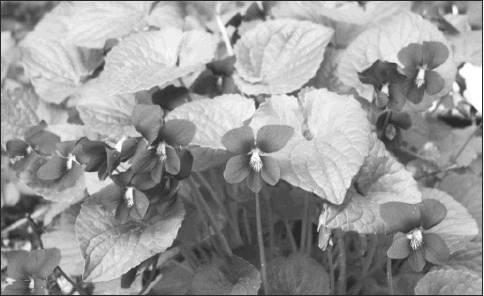Getting Into Gardening
With Valentine’s Day occupying much of what is on people’s minds this month it should come as no big surprise that February is a big month for flowers. But, oddly enough, the red rose is not February’s birth month flower! The February birth month flowers are the violet and the primrose.
Violets, one of the birth flowers of February, brighten any room with lovely blooms that symbolize loyalty, making them the perfect gift. These purple blossoms are a lot more than just pretty fragrant florals, though. There are between 400 and 500 species of violets, which span dozens of countries across the world. The most common species of violet found in the U.S. – though there are around 60 species found in the country – is the blue violet, or Viola sororia. Sweet violets, also called Viola odorata, are known for their scent. And while they can also be found in the U.S., they’re native to Europe and Asia. Despite their name, African violets are actually not a species of violet – they’re part of the Gesneriaceae family, which includes other flowering house plants.
True violets have been cultivated for centuries, with the earliest known use of the flowers dating back to Ancient Greece in 500 B.C., if not earlier. The Greeks used violets in their wines, foods and medicines, and they actually loved the flower so much that it became the symbol of Athens.
Violets were once considered indispensable perennials for the well-designed Texas garden. Although numerous native violet species occur in Texas, the violet of choice for most southern gardens was V. odorata, which is of European, Asian, and African origin. Dark blue or purple is the predominant color. Well into the early 20th century, violets were among the most popular florist cut flowers. Their fragrance, rich colors, and relatively easy culture contributed to nationwide popularity.
Violets prefer a rich, moist but well drained soil high in organic content. Partially shaded locations are preferred. Though most violets prefer shady and cool areas with moist soil, the blooms are known for being hardy and able to adapt to most environments. That’s because the flowers grow in many different climates and habitats worldwide, including woodlands, deserts and marshes. Their natural bloom period is late winter and early spring. Although evergreen, garden violets will become semi-dormant during our long, hot summers. But these little beauties are tough, and they can endure considerable drought and heat stress, and usually become lush and healthy again with the onset of cooler and more moist fall and winter conditions.
Landscape uses include borders and ground covers. Large container shrubs can often be enhanced by a mass of violets at their base, providing attractive foliage, fragrance, and color at a season when few other plants are at their peak. Mature height for violets is usually around 8 to 10 inches. The rounded foliage stays green nearly all year so it is attractive even when the plants are not in bloom.
Usual propagation is by division of mature clumps during early to mid-fall, which make violets a real bargain as you can multiple them without having to spend another penny. Seeds can also be used to produce new plants, but require considerable attention during the early stages and they divide so darn well that I almost never grow them from seeds.
Borders of garden violets may still be found in some of the old gardens of East and Central Texas. They can be long-lived and relatively low-maintenance perennials. Few plants perform as well in shady areas and offer color and fragrance during January, February, and March. Availability in nurseries is often inconsistent for some strange reason, but garden centers specializing in perennials or native Texas plants usually offer violets.
Many people use violets in recipes for a variety of savory dishes, and the petals are commonly coated with sugar and used on cakes, chocolates and pastries as sweet garnishes. What many people don’t know about the edible flowers is that they’re actually fairly nutritious. The petals and stems of violets contain high amounts of vitamin C, an antioxidant that can improve the immune system and overall health. In fact, the flower has more vitamin C than most other vegetables.
One thing violets are known most for is the fact that they have a lovely scent that seems to go away after just one sniff. That’s because the flowers contain a chemical called ionine which desensitizes the nose and sense of smell temporarily. Still, the scent is widely used in perfumes, lotions and oils because it’s so well-liked.
The other February birth flower is the primrose. While primroses do not belong to the rose family, their name originates from either the Old French word primerose or the medieval Latin prima rosa, both meaning “first rose”. Primroses are synonymous with cottage gardens and, being a woodland plant, they love light shade and moist soil. Plant them under a tree for a brilliant Spring display.
Giving primroses as a gift conveys the message that you can’t live without the recipient; serious stuff for such a pretty little flower!
Primroses can be found in red, pink, white, yellow, orange, purple, and blue. In our part of the country we are blessed with the Pink Evening Primrose, also called Mexican evening primrose, as one of our lovely wildflowers. You have no doubt seen them, they have flowers that start out whitish and turn to dark pink. They are a perennial, vanishing in the summer heat, but re-emerging again in cool weather to bloom every spring. They also have yellow, powdery pollen pistils, leading many old timers to call them buttercups.
These Primrose normally only grow to about 8 to 12 inches tall and 15 inches wide in the landscape. But they can get much wider if given plenty of space. It spreads so easily that it makes a great ground cover, especially for large natural areas. As its name suggests, the flowers open in the evening but also during the day.
This pretty pink beauty is very happy in the least cared for part of your landscape. It does great in rocky, shallow soils with no supplemental irrigation so don’t water these plants too much once established. They don’t respond well to that and can even get root rot if over watered. It also does well in natural, field plantings with other wildflowers. The Pink Evening Primrose spreads underground during winter months so it is likely to pop up almost anywhere in the yard the following spring!
February’s birth flowers are all about the promise of the coming spring, aren’t they? They may be small and unassuming, but after the long cold of winter months they feel very special – and they also give us an exciting little hint of what’s to come as the weather warms up.



